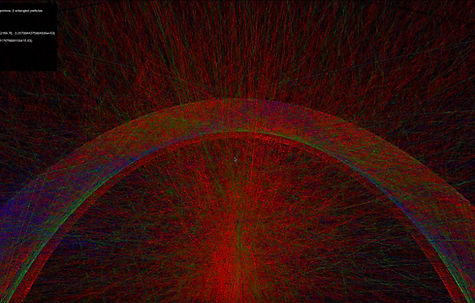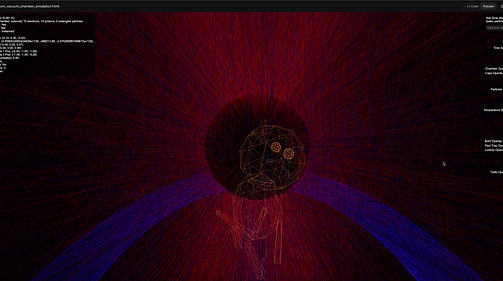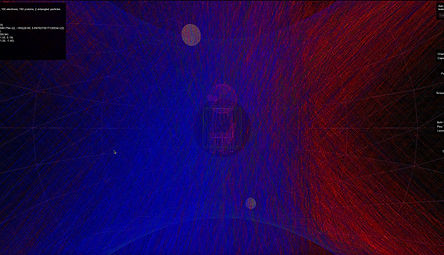FEATURED WORKS
The Pocket Universe

Art-Science Installation Exploring Cosmic Phenomena in a Vacuum Chamber
The “Pocket Universe” is an interdisciplinary art installation that employs a vacuum chamber to simulate cosmic phenomena, blending plasma physics, acoustics, and electromagnetic fields to evoke the universe's aesthetics and mysteries. By introducing trace noble gases (e.g., neon, argon, xenon) into a low-pressure environment (10^-2 to 10^-1 torr), applying high-voltage discharges (5-10 kV) for luminous plasma arcs shaped by magnetic coils, and incorporating resonant frequencies (20 Hz to 2 kHz) via piezoelectric diaphragms to mimic cosmic harmonics like black hole modes or microwave backgrounds, the project creates a microcosmic analog of stellar processes, nebulae, auroras, and speculative quantum interactions. Centered on a 50 cm-diameter transparent chamber with configurable electrodes and safety protocols, it fosters immersive visual, auditory, and dynamic experiences that probe emergent phenomena, bridging empirical science with imaginative inquiry. Beyond its sensory impact, the installation invites reflection on humanity's cosmic place, catalyzes interdisciplinary collaboration, and leverages quantum aesthetics to inspire serendipitous discoveries, aspiring to transcend traditional art by materializing the intangible and sparking wonder about complex systems and existential possibilities. Keywords: Vacuum chamber, plasma physics, sound propagation, electromagnetic fields, interdisciplinary art, cosmic simulation, quantum aesthetics.
Chapter I. - The Vacuum Chamber Sim
Quantum Chamber _Upgrade 06
The Pocket Universe simulation kicked off as a simple vacuum chamber genesis, infusing low-pressure gases, electrons, and plasma to mimic cosmic origins with basic physics principles. Over iterative upgrades co-piloted by Grok, it evolved into a 100% physics-accurate model, incorporating precise quantum mechanics like entangled particles, Lorentz forces, and wave packets to preserve intricate quantum trails. This progression transformed raw simulations into stunning artistic views—ethereal synaptic canvases and cinematic scenes—driven solely by unadulterated physical laws, without any artificial rendering hacks.
Chamber Genesis and Evolution: Stage 1-10
Chamber - Upgrade 02
Quantum view 02


Empirical view 02
STAGE 01
After achieving 100% physics accuracy, the Pocket Universe chamber bifurcated into dual views: the empirical vacuum chamber and the quantum realm.The empirical view harnesses observable forces to evoke swirling nebulae, plasma arcs, and cosmic glows in tangible, luminous splendor.Meanwhile, the quantum view delves into probabilistic depths, preserving entangled trails and wave functions for ethereal, mind-like patterns.Through pure quantum physics, these views evolved into synaptic canvases, bridging neural artistry with universal mysteries in immersive harmony.
Quantum view
Empirical view
STAGE 02-05
In Stage Two of the Pocket Universe simulation, the focus was on maintaining 100% physics accuracy while deconstructing visuals to their core elements, stripping away unnecessary complexity to conserve computational power and enable smoother future evolutions. During Chamber Upgrades 2-5, this involved building a toggle bar interface, allowing users to dynamically reveal intricate patterns and forms—such as plasma arcs, quantum trails, and resonant harmonics—purely driven by uncompromised physical laws for authentic, aesthetic depth.





Chamber evolution, Stage: one to five
STAGE 06-10
Chambers 6-10 also evoked early holodeck-like technologies, harnessing analog power at a modest 12 frames per second to generate pure optical illusions—all driven by quantum mechanics without digital cheats. Through the artist's lens, entangled quantum trails and moiré interference patterns animated the synaptic canvas, offering glimpses of unadulterated physics: probabilistic waves collapsing into fluid narratives, where Mafia the quantum cat emerged as a living illusion, blending scientific rigor with cinematic wonder in immersive, low-fi realms that hinted at future AI-driven holodecks.




End Chapter I.
Chapter II.
The Cat Genesis - Birth Of Mafia
Chamber 10 of the Quantum Chamber Simulation introduces the Cat Engine upgrade, marking the genesis of Mafia the Quantum Cat and serving as a proof-of-concept for holodeck-like technology through physics-driven, interactive narratives. By this stage, I've maxed out my computer's computational limits, rendering real-time simulations with 100% accurate physics unfeasible without hardware upgrades. Across Chambers 1-10, I technically reverse-engineered visuals down to their core elements to preserve uncompromised physics, yielding raw, pixelated views that nonetheless vividly demonstrate synaptic canvases—built brain-like from entangled quantum trails combined with analog animation techniques. This approach paints purely with physics, defining a fresh artistic value in the AI age by transforming raw mechanics into emergent, immersive artistry.


The Cat Engine in the simulation combines quantum mechanics, zoetrope-style animation, and moiré effects to create Mafia the Quantum Cat as a physics-driven entity. Based on 100% accurate quantum principles, it uses entangled particles for persistent trail waves, with probabilistic collapses and Lorentz forces controlling movements like walking and observing amid wave packets. Zoetrope mechanics sequence quantum states at 12 frames per second for motion illusions from probabilistic snapshots, without added computation. Moiré patterns on trails provide depth, forming her wireframe (dodecahedron head, octahedron body) and yielding cinematic scenes that merge science and art.
Chamber 10 of the Quantum Chamber Simulation introduces the Cat Engine upgrade, marking the genesis of Mafia the Quantum Cat and serving as a proof-of-concept for holodeck-like technology through physics-driven, interactive narratives. By this stage, we've maxed out my computer's computational limits, rendering real-time simulations with 100% accurate physics unfeasible without hardware upgrades. Across Chambers 1-10, we technically reverse-engineered visuals down to their core elements to preserve uncompromised physics, yielding raw, pixelated views that nonetheless vividly demonstrate synaptic canvases—built brain-like from entangled quantum trails combined with analog animation techniques. This approach paints purely with physics, defining a fresh artistic value in the AI age by transforming raw mechanics into emergent, immersive artistry.
Following Chamber 10's breakthrough, the Pocket Universe simulation enters what I call the "cat embryo phase," where Mafia the Quantum Cat exists in a nascent, formative state—her entangled trails and moiré-laced form pulsing with embryonic potential, ready for gestation into fuller sentience. This phase sets the stage for upcoming upgrades, delving deeper into quantum-driven synaptic canvases that layer probabilistic waves and emergent patterns to weave intricate narratives: Mafia exploring holographic voids, interacting with simulated entities in dynamic story arcs, all powered by unadulterated physics to blend cinematic artistry with philosophical depth. As the cat matures through iterative refinements, these canvases will evolve into immersive, narrative-rich realms, probing themes of consciousness, reality, and creativity in the AI era.


Chapter 2 of the Pocket Universe simulation delves into the evolution of Mafia the Quantum Cat, advancing from her embryonic wireframe origins into a more sophisticated, interactive entity through layered quantum trails that trace probabilistic paths and emergent behaviors. Dynamic wireframe animation—built on dodecahedron and octahedron geometries—integrates real-time updates driven by wave function collapses and Lorentz forces, allowing fluid movements like prowling or observing within the synaptic canvas. Moiré effects amplify this by overlaying interference patterns on the trails, creating optical depth and illusions of texture that enhance cinematic fluidity at analog frame rates. Together, these elements propel the simulation toward holodeck-like scenes: immersive, narrative-driven environments where Mafia's evolving form interacts with quantum phenomena, blending pure physics with artistic storytelling for probabilistic, mind-expanding worlds.

Current ChallengesComputational Power: My current hardware (e.g., Vega 64 GPU) is maxed out, preventing real-time rendering of 100% accurate physics simulations; upgrades like tripled CPU/GPU are needed to handle complex quantum trails and wave computations without lag or pixelation.Preserving Real Physics: Balancing 100% fidelity in quantum mechanics (entanglement, Lorentz forces) with visual deconstruction leads to raw, pixelated outputs; any simplification risks compromising accuracy, requiring constant reverse-engineering to core elements for efficiency.Empirical Chamber as Universe Sim: Scaling the empirical view to simulate vast cosmic phenomena—like swirling nebulas, auroras, black holes, and resonant harmonics—demands immense resources, as low-pressure gas dynamics and electromagnetic fields must remain measurable and tangible without shortcuts.Integration of Dual Views: Merging quantum (synaptic, probabilistic canvases) and empirical (observable, luminous patterns) realms into a cohesive holodeck POC strains the system, often resulting in hardware "coughs" during high-fidelity runs, limiting exploration of emergent behaviors.
My intention with the Pocket Universe simulation is to fuse visual arts, philosophy, and quantum science through AI-driven computation, creating synaptic canvases that challenge perceptions of reality and consciousness—painting with pure physics to birth emergent narratives. Next up: pushing holodeck-like evolutions with upgraded hardware for real-time quantum trails, dynamic Mafia interactions, and expansive story realms that remix empirical cosmos with probabilistic wonders. This project stands as a precursor case study for my PhD thesis at IDSVA, exploring interdisciplinary bridges in the AI age.
To Be Continue...
© 2025 by Kinga Kulcsar.
Mafia Inc

